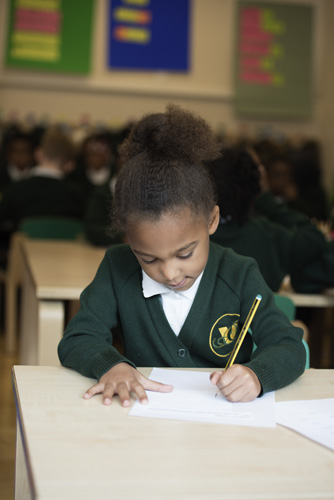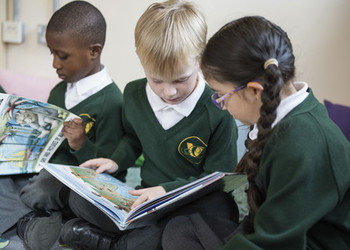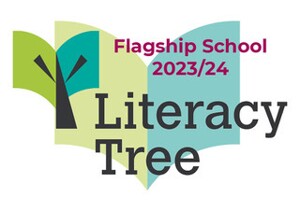English (including Phonics, Reading & Writing)
“Write to be understood, speak to be heard, read to grow”
Lawrence Clark Powell
Reading lies at the heart of the curriculum at Van Gogh Primary. We are dedicated to enabling our pupils to become life-long readers and view reading as key to academic success. We believe that every child has the right to learn to read and our aim is for them to also develop an enjoyment of reading as soon as possible. We promote enjoyment through the creative use of high quality texts and a range of engaging activities. Teachers view themselves as reading role models in the way that they discuss and promote books as well as modelling reading for pleasure. We make careful selections both in the texts that are chosen to use in the teaching of English, and in those that they read aloud to pupils. Children are read to daily. This not only allows them to encounter more demanding texts in a safe environment but also aids their vocabulary growth.
 All pupils should be able to confidently communicate their knowledge, ideas and emotions by expressing themselves through their speech and writing. In order to do so, we enable pupils to acquire a wide range of vocabulary, a clear understanding of grammar and the ability to spell new words by effectively applying the spelling patterns and rules they learn throughout their time in primary school.
All pupils should be able to confidently communicate their knowledge, ideas and emotions by expressing themselves through their speech and writing. In order to do so, we enable pupils to acquire a wide range of vocabulary, a clear understanding of grammar and the ability to spell new words by effectively applying the spelling patterns and rules they learn throughout their time in primary school.
We provide our pupils with the tools to write clearly, coherently and accurately by adapting their language and style for a range of purposes and audiences. We believe it is fundamental that we develop a habit of neat, joined up handwriting by the time they move to secondary school and this journey begins in Year 2. It is also vital that all writers are able to refine and edit their writing over time, so that they can develop their independence in being able to identify their own areas of improvement.
DET Curriculum Principles
-
The Bigger Picture
Lessons follow a narrative and form part of a coherent map which is effectively sequenced and planned. As a result, students are supported to build schemas in their long-term memory to help retention and support application of knowledge.
-
Knowledge Rich
The subject curricula combine a rich blend of knowledge and the related disciplinary skills. Acquiring fundamental knowledge and being able to quickly access relevant information from memory are prerequisites for deeper learning and reasoning.
-
Literacy Development
Literacy is at the heart of the curriculum and students’ ‘disciplinary literacy’ is prioritised. Vocabulary rich lessons ensure students have the opportunity to develop their vocabulary (including tier 2/3 vocabulary) , extending knowledge and helping them to become confident communicators and learners. Students have the opportunity to read appropriately complex texts, break down complex writing tasks, combine writing instruction with reading and use structured talk in order to increase students’ understanding across the curriculum. Where necessary students are provided with individual literacy support in support of the aim for all to leave school with the ability to comprehend and communicate effectively through reading, writing, speaking and listening skills.
-
Enrichment
Varied experiences enrich lives, engage imaginations, stretch skills and allow students to think creatively and independently. We recognise that reading is an essential tool in developing layers of meaning and knowledge - simply put, read more and know more.
We strive for every pupil to leave us with the necessary skills and vocabulary to meet the demands of the secondary curriculum and for them to be successful throughout their lives. We believe that no child should be left behind.
To ensure this is consistent throughout the school in our English, we follow the following holistic approaches:
1. Oracy and spoken language
English begins with the spoken language. We believe this is fundamental because language forms the foundations for interacting with other people – for communicating our needs, our thoughts and our experiences.
2. Systematic Synthetic Phonics
From Nursery, children are introduced to our programme for phonics: ‘Read Write Inc’. They are taught to read letters, or groups of letters, by saying the sound they represent and then blend these sounds to form words. Phonics lessons are taught in small groups to ensure that learning is targeted to children’s individual needs. Our programme for phonics follows these principles in order to get children’s ‘COGS’ working:
-
Everything CONNECTS: children connect sounds with mnemonic pictures; words with their meanings; and stories with the sounds they know. They connect their own experiences to the stories they read and learn to lift the words off the page.
-
Children learn ONE thing at a time and practise it until it becomes second nature. Interactive practice keeps children focused, and their capacity to learn develops exponentially.
-
They learn at their GOLDILOCKS spot (not too easy, not too hard) with others at a similar challenge level. No time is wasted.
-
Children remember what they learn by SAYING it out loud to a partner. If they can’t explain it, the teacher repeats it until they can
3. Whole-class guided reading
 Once pupils have completed our phonics programme, they move onto the ‘Literary Leaves’ programme for reading. This is taught as a whole-class guided session in order to expose all pupils to high-quality language and discussion. Teachers use whole books rather than extracts in order to increase engagement and reading stamina when teaching the skills of comprehension. Pupils spend between 2 to 4 weeks studying one text, each session focussing on a particular skill, to ensure that children develop the skills to become critical readers.
Once pupils have completed our phonics programme, they move onto the ‘Literary Leaves’ programme for reading. This is taught as a whole-class guided session in order to expose all pupils to high-quality language and discussion. Teachers use whole books rather than extracts in order to increase engagement and reading stamina when teaching the skills of comprehension. Pupils spend between 2 to 4 weeks studying one text, each session focussing on a particular skill, to ensure that children develop the skills to become critical readers.
Our principles of whole-class guided reading:
-
Children work in mixed-attainment pairs so as to allow for frequent, paired discussion and so that less confident readers are exposed to the high-quality reasoning of more confident readers.
-
Texts chosen should provide a clear challenge for all members of the class, including the most-able readers.
-
When reading, the teacher should model good use of intonation, movement, volume and expression in order for pupils to emulate this. As well as reading aloud to their class, teachers might use the following strategies for oral reading: whole-class choral reading, ‘jump-in’ and paired reading.
-
Teachers actively monitor the pace of their reading so as to ensure high levels of engagement throughout the lesson. Teachers intersperse longer stints of reading with paired discussions or independent tasks.
-
Teachers use targeted and open-ended questioning.
-
When discussing literature, the teacher models high-quality responses with evidence and explanations and expects these high-quality responses from pupils too. Teachers use question stems in order to encourage high-quality responses from pupils. For example:
“The author has used the word ___________ to suggest ___________ because it is associated with ___________ .”
4. Teaching is underpinned by a high-quality text
Each new unit for English starts with a beautiful, high-quality text. These texts offer opportunities for empathy and philosophical enquiry, developing the spoken language though through debate, drama and discussion, which will spark their imagination. Our texts have been specifically chosen so that pupils are exposed to:
-
Classic novels
-
The works of Shakespeare
-
Current and controversial world affairs, e.g. ‘global warming’ and ‘gender equality’
-
Variety of different cultures, ethnicities and faiths through stories
-
Books which are relevant to our locality and community
5. Spelling and Grammar is embedded
Spelling and grammar is taught through the context of a book so that these can be applied purposefully within writing.
6. Children write for a purpose
Children have real reasons to write whether that is to explain, persuade, inform or instruct, usually on a daily basis. Within each sequence of teaching, pupils will write for different purposes and will practice their skills creating ‘shorter’, ‘longer’ and ‘extended’ writing outcomes.
7. Keep up, not catch up
Teachers plan lessons to ensure all children are challenged appropriately. However, we recognise that for varying reasons, some children need more support in their learning. Throughout lessons, adults will work with guided groups to support their vocabulary acquisition, sentence construction and demonstrate the writing process.
Pupils who need additional support with their reading or phonics are provided with targeted intervention using the ‘Read Write Inc’ programme. For pupils in KS1, this is a one-to-one session which takes place for 10 minutes during the afternoon. Those in KS2, follow the ‘Fresh Start’ programme which takes place during the whole-class guided reading session.
Our curriculum
New curriculum map to follow
How are reading and writing taught?
How is Reading taught in Early Years and KS1?
In the early stages of reading, children’s phonic knowledge is systematically developed through the ‘Read Write Inc.’ (RWI) programme. RWI helps pupils understand how letters are linked to sounds (phonemes) to form letter-sound correspondences and spelling patterns to help learn how to apply this knowledge in their reading. Pupils are assessed regularly against the termly assessments, which informs future planning and also allows teachers to identify any gaps within their learning.
How is Reading taught in KS2?
Once pupils have completed our phonics programme, they move onto the ‘Literary Leaves’ programme for reading. This is taught as a whole-class guided session in order to expose all pupils to high-quality language and discussion. Teachers use whole books rather than extracts in order to increase engagement and reading stamina when teaching the skills of comprehension. Pupils spend between 2 to 4 weeks studying one text, each session focussing on a particular skill, to ensure that children develop the skills to become critical readers.
How is Writing taught across the school?
Before the text is introduced, teachers create ‘hooks’ as an engaging starting point to generate curiosity and as a stimulus for class-discussion. Each unit lasts between 2 to 4 weeks and texts are sometimes linked to the wider curriculum.
Each new unit for English starts with a beautiful, high-quality text. These texts offer opportunities for empathy and philosophical enquiry, developing the spoken language though through debate, drama and discussion. Children have real reasons to write whether that is to explain, persuade, inform or instruct, usually on a daily basis. Within each sequence of teaching, pupils will write for different purposes and will practice their skills creating ‘shorter’, ‘longer’ and ‘extended’ writing outcomes.
Spelling and grammar is taught through the context of a book so that these can be applied purposefully within writing. Immediately after a new skill is taught, pupils apply their learning in a meaningful context within the lesson. Teachers come back to these spelling and grammar skills again and again in order to embed learning. Our classrooms are rich in talk, questions are planned, peer conversations are modelled and scaffolded and the teacher uses talk skilfully to develop thinking.
We have evolved the following opportunities to develop pupils’ spoken language:
-
A rich language environment in the Early Years
-
Oracy skills are explicitly taught through our Phonics and Mathematics programmes
-
High-quality texts are used as a stimulus for high-quality discussions
-
‘Fantastic Finish’ events allow pupils to showcase their learning to a small group of adults or in front of an audience
-
Child-led assemblies once per term
-
Debating competitions
Literacy Tree Flagship School

Our English Curriculum
At Van Gogh Primary School, we teach English by following the Literacy Tree. Literacy Tree is a complete, thematic approach to the teaching of primary English that places children’s literature at its core. We are immensely proud that our school has been chosen as a Literacy Tree Flagship School for our innovative use of the book-based approach across our school.
How does it work?
Literacy Tree is an award-winning platform which has designed a curriculum which
immerses children in a literary world, therefore creating strong levels of engagement
to provide meaningful and authentic contexts for primary English. Children become critical readers and acquire an authorial style as they encounter a wide-range of significant authors and a variety of diverse fiction, non-fiction and poetry.
As a whole-school approach, children explore at least 100 literary texts and
experience over 75 unique significant authors as they move through the school.
It provides complete coverage of all National Curriculum expectations for writing
composition, reading comprehension, grammar, punctuation, and vocabulary, as
well as coverage of spelling. All plans lead to purposeful application within a wide
variety of written outcomes.
At our school, the Literacy Tree texts are mapped out to ensure progression and
National Curriculum coverage across all year groups.
For more information about Literacy Tree please look at our website
SEND & Inclusion
As in all areas of the curriculum, teachers should deliver ‘quality-first’ teaching and differentiate to support children with barriers to learning. On an individual basis, teachers should consider any limitations that a child has in accessing the planned lesson and provide:
-
Adapted tasks and correct adult support
-
‘InPrint’ helps generate key vocabulary, and colourful semantics to aid children in forming their sentences accurately for careful differentiation.
-
Oral communication, as mentioned above is the basis of promoting speaking and listening. This is incorporated into the lessons daily, to give all children the ability to express their thoughts.
-
Visual cues are incorporated into each lesson, to create a link between the book and the task set.
-
Regular opportunities to reuse/recap key concepts and vocabulary throughout the day.



